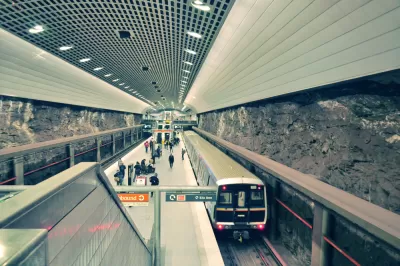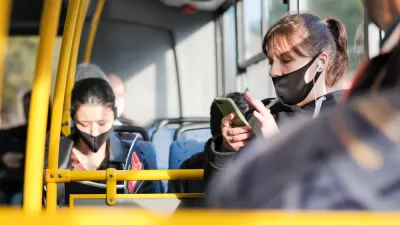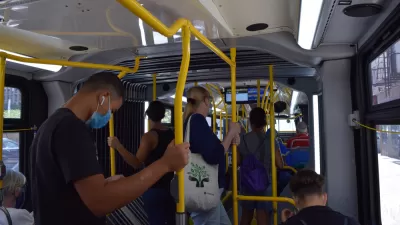After seeing dramatic cuts in service and ridership during the pandemic, transit agencies have a small window of opportunity to gain and retain regular passengers.

Because "we’re in the midst of an unprecedented period when millions of people are reevaluating their travel habits," writes David Zipper for Bloomberg CityLab, now is the time for transit agencies to radically rethink their strategies for attracting and retaining passengers. "If there is ever a time for local leaders to nudge residents toward transit and away from driving, this is it."
Zipper recommends several tactics for getting more people on buses and trains, such as offering free tickets, multimodal rewards, touchless payments, and emergency car rides for regular riders, a service implemented by several agencies before the pandemic. "These programs provide a kind of insurance if a rider urgently needs to travel at a time when bus or train service is unavailable (i.e., a mid-day trip to pick up a sick child at school, or a ride home after unexpectedly needing to work late). Ideally, they will enable more residents to opt for transit, secure in the knowledge that they can handle a sudden emergency without breaking their travel budget."
Zipper cautions, however, that while these small fixes can help make transit more accessible and more attractive, "[p]retty much everyone agrees that the key to sustained transit ridership growth is providing reliable, frequent and accessible service. Thankfully, an infusion of federal funds has now allowed many agencies to bring service back to pre-pandemic levels."
FULL STORY: 4 Ways Transit Can Lure Back Post-Covid Commuters

Alabama: Trump Terminates Settlements for Black Communities Harmed By Raw Sewage
Trump deemed the landmark civil rights agreement “illegal DEI and environmental justice policy.”

Planetizen Federal Action Tracker
A weekly monitor of how Trump’s orders and actions are impacting planners and planning in America.

The 120 Year Old Tiny Home Villages That Sheltered San Francisco’s Earthquake Refugees
More than a century ago, San Francisco mobilized to house thousands of residents displaced by the 1906 earthquake. Could their strategy offer a model for the present?

In Both Crashes and Crime, Public Transportation is Far Safer than Driving
Contrary to popular assumptions, public transportation has far lower crash and crime rates than automobile travel. For safer communities, improve and encourage transit travel.

Report: Zoning Reforms Should Complement Nashville’s Ambitious Transit Plan
Without reform, restrictive zoning codes will limit the impact of the city’s planned transit expansion and could exclude some of the residents who depend on transit the most.

Judge Orders Release of Frozen IRA, IIJA Funding
The decision is a victory for environmental groups who charged that freezing funds for critical infrastructure and disaster response programs caused “real and irreparable harm” to communities.
Urban Design for Planners 1: Software Tools
This six-course series explores essential urban design concepts using open source software and equips planners with the tools they need to participate fully in the urban design process.
Planning for Universal Design
Learn the tools for implementing Universal Design in planning regulations.
Clanton & Associates, Inc.
Jessamine County Fiscal Court
Institute for Housing and Urban Development Studies (IHS)
City of Grandview
Harvard GSD Executive Education
Toledo-Lucas County Plan Commissions
Salt Lake City
NYU Wagner Graduate School of Public Service





























